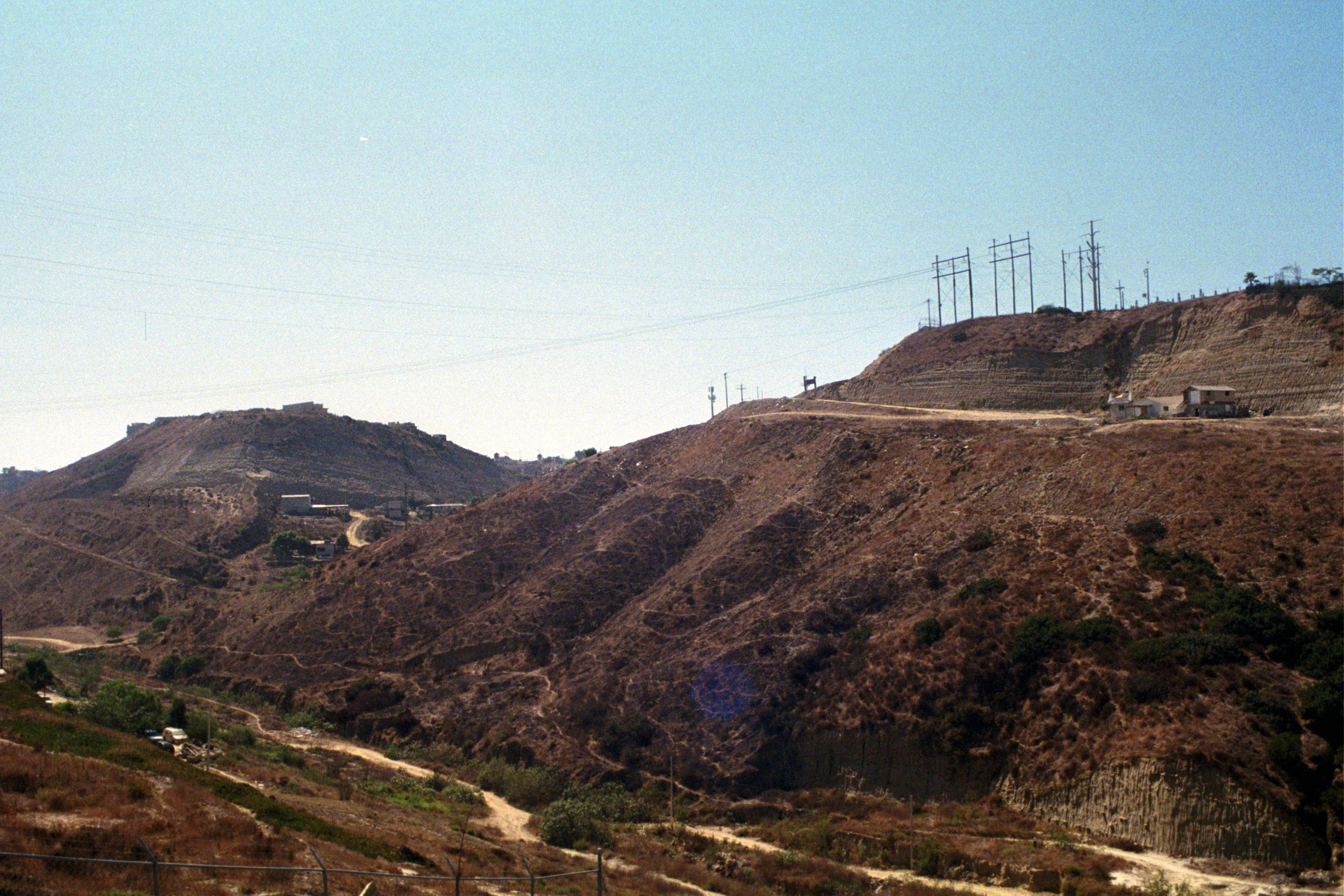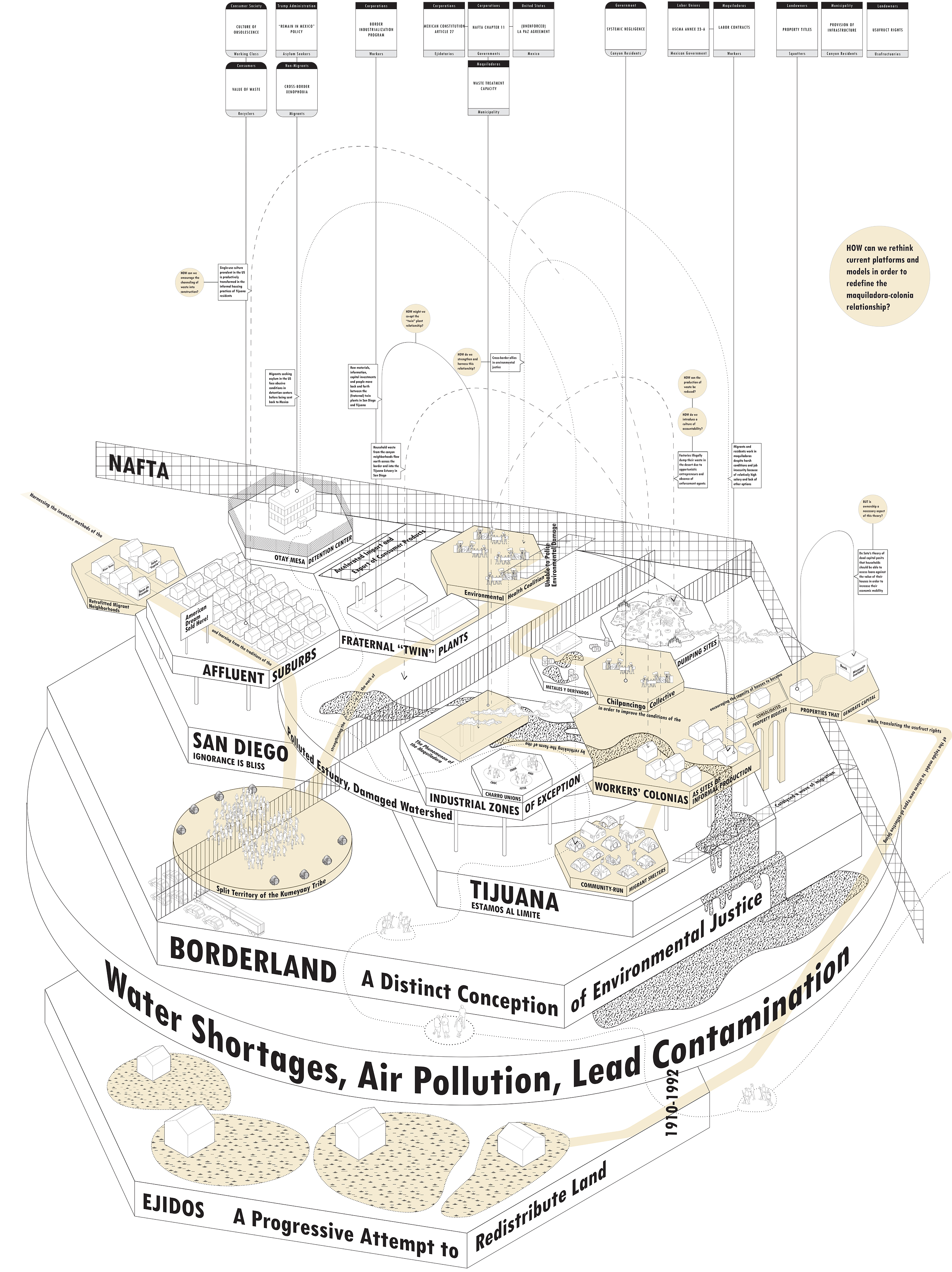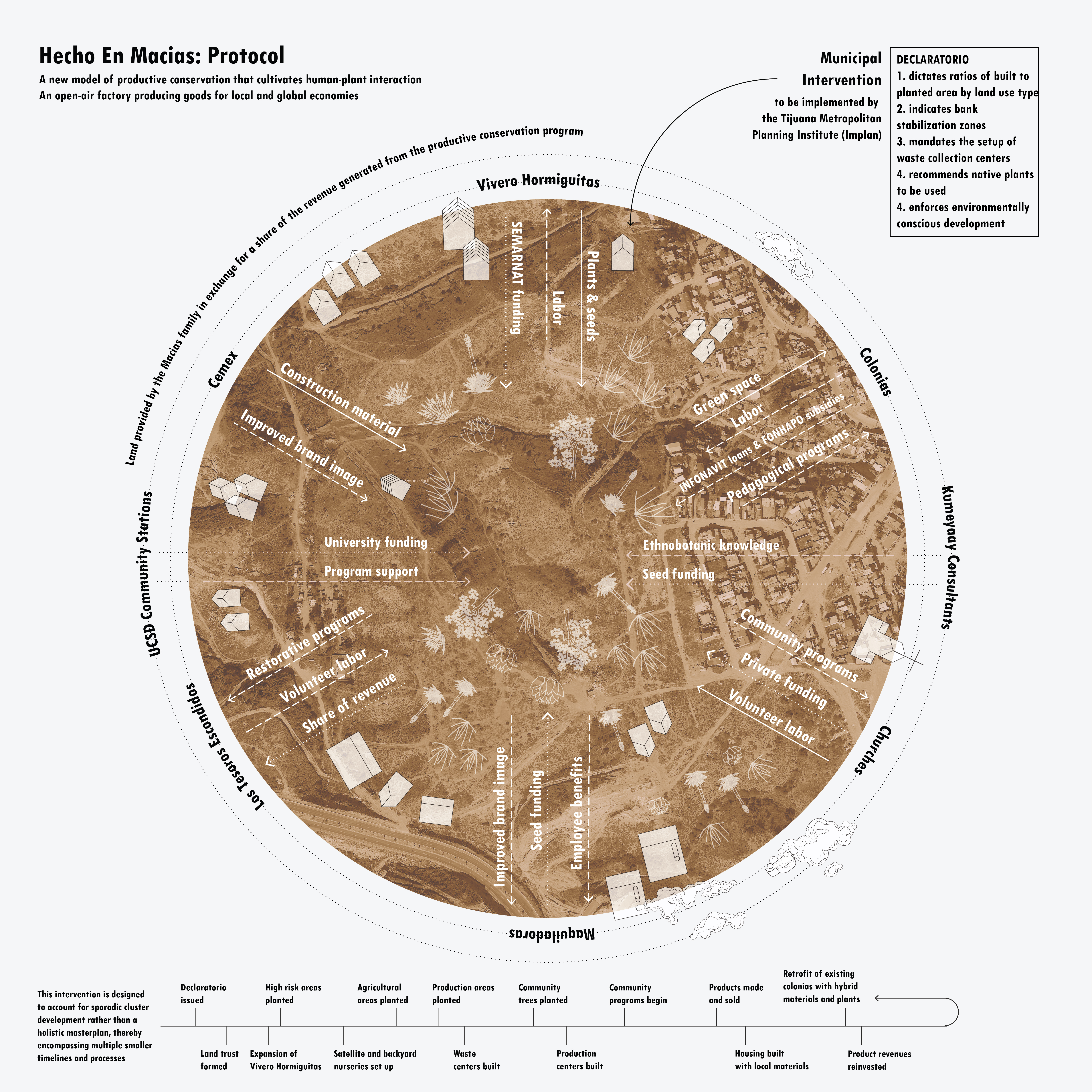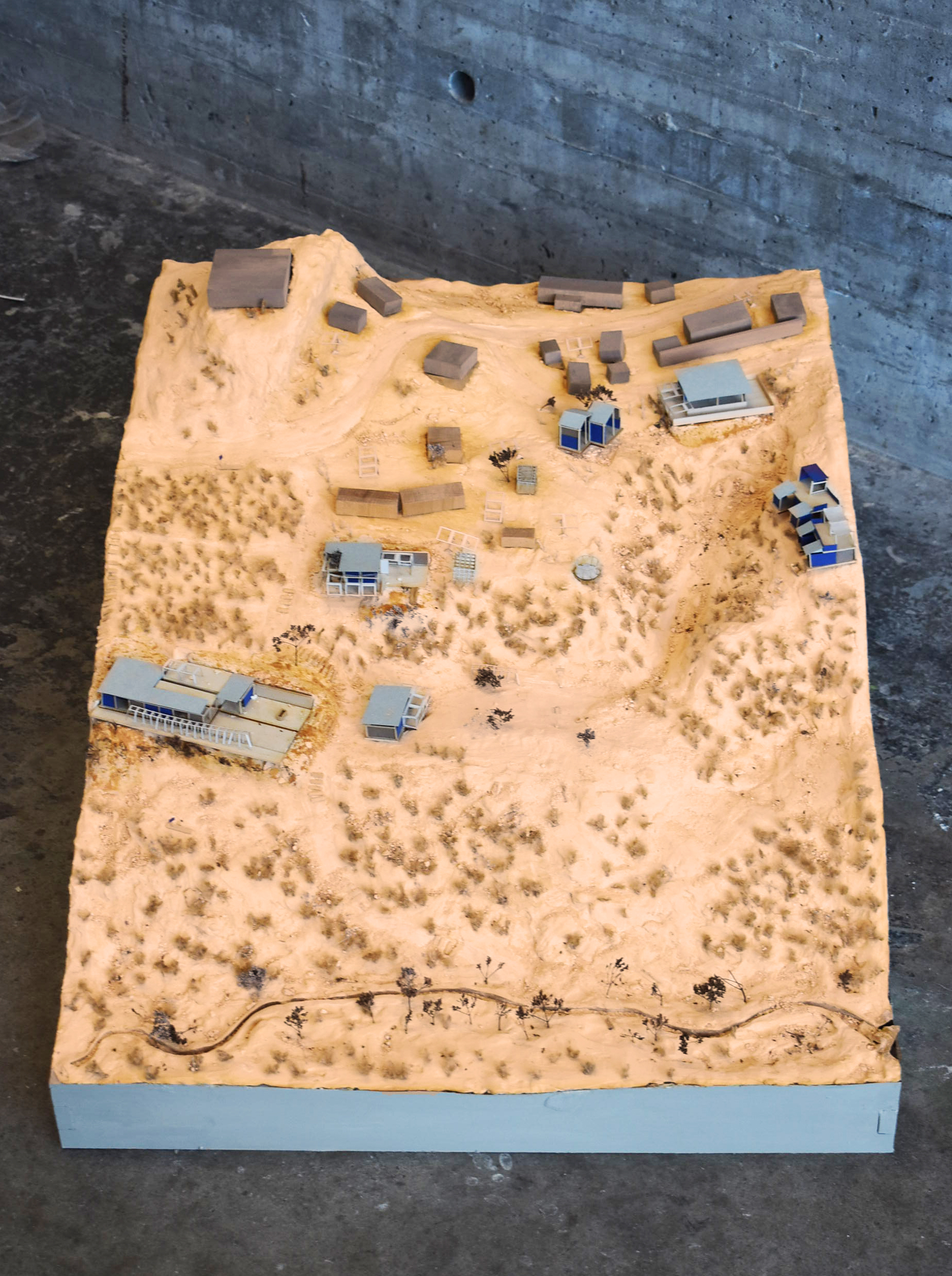Cross-Border Commons / Fall 2019
Advanced Studio with Teddy Cruz, Fonna Forman, and Marta Caldeira
Partner: Maya Sorabjee
Advanced Studio with Teddy Cruz, Fonna Forman, and Marta Caldeira
Partner: Maya Sorabjee
GROWING ⋅ TOGETHER
Summary
Our project critiques existing manufacturing practices along the US-Mexico border as well as prevailing models of land conservation, in order to propose an alternative system centered on human-plant coevolution.
We worked with a 250 acre site, Ranchos Macias, which many activists have been trying to conserve, as it is a crucial part of the Tijuana-San Diego bi-national watershed, located furthest upstream and is relatively undeveloped. Our challenge was figuring out the process by which new paradigms of conservation could be accomplished, while integrating a wide range of seemingly disparate stakeholders who surround the site. This paradigm is not the static notion of conservation that antagonize urbanization, community and economic development, but a type of conservation that is generative of productive local social, environmental and economic relations; new interfaces between top down institutions and bottom up agency; and local and global flows that prioritize empowering the colonias.
The plants that grow naturally in the area, like Jojoba and Agave, became central to this challenge and have helped guide our project “Growing Together.”
We worked with a 250 acre site, Ranchos Macias, which many activists have been trying to conserve, as it is a crucial part of the Tijuana-San Diego bi-national watershed, located furthest upstream and is relatively undeveloped. Our challenge was figuring out the process by which new paradigms of conservation could be accomplished, while integrating a wide range of seemingly disparate stakeholders who surround the site. This paradigm is not the static notion of conservation that antagonize urbanization, community and economic development, but a type of conservation that is generative of productive local social, environmental and economic relations; new interfaces between top down institutions and bottom up agency; and local and global flows that prioritize empowering the colonias.
The plants that grow naturally in the area, like Jojoba and Agave, became central to this challenge and have helped guide our project “Growing Together.”

Research Approach
Teddy Cruz and Fonna Foreman guided our initial research through a series of exercises (like the 5Ws Chart, the Conflict Diagram, and the Protocol), that helped our studio understand and address the multiple, multi-scalar, and multi-layered nature of issues in the Tijuana-San Diego region.
5Ws Chart




The 5Ws chart helped Maya and I better understand Tijuana’s maquiladoras (factories) as products of a fragmented yet integrated Borderland. Below are some of our key findings:
Tijuana contains hundreds of maquiladoras, manufacturing plants that benefit from reduced tariffs and report to a “twin” HQ on the other side of the border. These were setup in the 1960s and grew with NAFTA in the 1990s. We called them the “fairweather” factories because of their lack of integration with local communities and constant relocation to sites offering the cheapest labor. This made us realize that Tijuana is an acute manifestation of the larger flows of globalization, a “planetary constellation” of factories and products that feed insatiable consumer appetites. Much of the land that these factories sit on is former “ejido” land: communal agricultural land that was leased in “usufruct” by the government. This essentially meant the land was leased to farmers indefinitely on the condition that they could use it but not destroy it. This concept of “usus” but not “abusus” became an underlying concept in our project. Ejido land was allowed to be privatized after NAFTA in order to make way for the influx of the maquiladoras. Given the lack of labor protection, our 5Ws chart also accounts for the many bottom up actors who have had to fight for the safety of their environment and their rights as workers.
Tijuana contains hundreds of maquiladoras, manufacturing plants that benefit from reduced tariffs and report to a “twin” HQ on the other side of the border. These were setup in the 1960s and grew with NAFTA in the 1990s. We called them the “fairweather” factories because of their lack of integration with local communities and constant relocation to sites offering the cheapest labor. This made us realize that Tijuana is an acute manifestation of the larger flows of globalization, a “planetary constellation” of factories and products that feed insatiable consumer appetites. Much of the land that these factories sit on is former “ejido” land: communal agricultural land that was leased in “usufruct” by the government. This essentially meant the land was leased to farmers indefinitely on the condition that they could use it but not destroy it. This concept of “usus” but not “abusus” became an underlying concept in our project. Ejido land was allowed to be privatized after NAFTA in order to make way for the influx of the maquiladoras. Given the lack of labor protection, our 5Ws chart also accounts for the many bottom up actors who have had to fight for the safety of their environment and their rights as workers.
Conflict Diagrams



We spatialized our research in our conflict diagrams, which uses circular and hexagonal platforms to respectively indicate environmental issues and human constructs. Thus in our zoomed out version, Tijuana and San Diego sit on top of a mountain of global flows, continental migration, and international trade deals. For instance, manufacturing fever of globalization has worsened climate change and caused the crops of farmers in central america to fail, prompting them to migrate to the border in search of economic opportunity, often in the factories themselves.
Zooming in, environmental injustices play out on a local scale with illegal dumping sites, contaminated water, and false labor unions that are actually government-backed. At this scale we can also see the Kumeyaay tribe, the indigenous community of the region, split in half by the arbitrary manmade border.
Zooming in, environmental injustices play out on a local scale with illegal dumping sites, contaminated water, and false labor unions that are actually government-backed. At this scale we can also see the Kumeyaay tribe, the indigenous community of the region, split in half by the arbitrary manmade border.
Virtuous Cycle
Our project questions the destructive and alienating conditions of present factories while attempting to co-opt their presence in order to propose new economic models.
The practice of “growing together” is one we consider necessary for the survival of our planet in the face of catastrophic climate change. Our project imagines a systematic growing of plants that become embedded within, rather than separated from, daily human practices ranging from waste management and urban development to intergenerational education and restorative practices. This allows plants and humans to enter a virtuous cycle in which manufacturing is in sync with the environment.
Site
Our site, Ranchos Macias, is about 250 acres and is largely undeveloped. As we mentioned earlier, its position in the watershed makes it critical to protect, as what gets eroded here goes downstream towards the estuary, and causes flooding in the canyon along the way. Despite the lack of development, trash is informally dumped throughout the site, typically at the smaller tributaries, and gets carried by rainfall into the main tributary.
While the land is privately owned, its edge is populated by a range of actors. Most notably, it is close to La Jolla Industrial Park, a small nucleus of maquiladoras on the southern end, while on its northern end is Vivero Hormiguitas, a native plant nursery that we visited on our studio trip. Each of the entities on the edge of Macias operates according to its own logic and source of funding. It is a string of disparate groups that could be brought together to address the future of this piece of land.
While the land is privately owned, its edge is populated by a range of actors. Most notably, it is close to La Jolla Industrial Park, a small nucleus of maquiladoras on the southern end, while on its northern end is Vivero Hormiguitas, a native plant nursery that we visited on our studio trip. Each of the entities on the edge of Macias operates according to its own logic and source of funding. It is a string of disparate groups that could be brought together to address the future of this piece of land.

This creates an existing edge that we hope to strengthen by creating a protective edge within the undeveloped portion of the site. This productive buffer zone allows the creation of both preventative and remedial strategies that protect the watershed, create a sustainable form of development, and address issues in the existing colonias.

The metaphorical and literal seed of our project is the plant nursery, as highlighted in the above image. In the image on the right is Jorge, manager of the plant nursery Vivero Hormiguitas. Jorge is a crucial character in Rancho Macias and his story greatly influenced the course of this project. For years, he has been cultivating the native plants of Baja California, known for their medicinal uses and ability to prevent erosion. His nursery acts as an educational space for the community to understand native plants for their anti-erosive and medicinal potential. People in the community often consider these plants as dead or ugly, uprooting them in favor plants that require more maintenance and water.
Plant-Based Knowledge
This chart indicates just a few of the 47 native plants we identified as particularly useful in this project, whether for stabilization, sustenance, or use in products like baskets or soap.
This information was derived from our study of the cultural traditions of the Kumeyaay tribe, which is a community that knows so much about the native plants of Baja California, as their culture espouses a highly integrated relationship with them. They use these plants for all kinds of purposes and transfer this knowledge through generations. For Growing Together, Kumeyaay consultants would thus advise local leaders on plants, conservation efforts, and artisanal techniques for transforming them into usable products.
The architecture that emerges from this process uses strategies of planting and elements of bio-construction to create a range of reconfigurable spaces, embodying our project’s central concept of plant-human integration and coevolution.
Concept
All of these practices can be summarized by the idea of human-plant interaction and coevolution. This stems from our critique of the existing model of conservation as one that separates the human and the plant into distinct zones, in which the protection of nature indirectly sanctions the abuse of urban environments. Instead we propose the concept of human-plant interaction as one that informs every scale of the project: from the entire site down to the unit of the ecobrick or the basket. Our model of conservation is one that includes the production and use of plants, a conceptual manifestation of the usufruct rights of the ejidos.
Bottom up vs. Top down
These are largely bottom up practices that need the support of top down institutions, especially as the profit motive typically doesn’t support these kinds of emergent economic models. So in order to implement this we propose the creation of a declaratorio by Implan, the municipal planning agency in Tijuana. A declaratorio is a device similar to eminent domain in which the state imposes rules on a piece of land. The key points are the creation of a zone around the primary and secondary tributaries that must be planted with stabilizing plants, the establishment of cash crop areas to grow jojoba and chia, two lucrative plants that will help fund the program, and the creation of ratios of built-to-planted area for different types of development.
The second aspect of our protocol utilizes the entities around the border in attempt to scale up each of their logics. These actors will engage in a quid pro quo exchange of assets. For instance the maquiladoras will provide philanthropic seed funding in exchange for employee amenities such as daycares and canteens, while also improving their brand image for their global consumer base. The rehab that exists on the southern edge of the site can offer the volunteer labor of patients, who already engage in a program of producing products for sale, in exchange for more restorative plant-based programs and a share of the revenue produced by the sale of products. A portion of this revenue will also go to the Macias family, in exchange for the use of the land, but it will mainly be reinvested in the productive conservation program.

Spectrum of Processes
We imagine that the physical manifestation of this protocol takes place not through solid architecture and a masterplan but a spectrum of processes that could accommodate the different circumstances that might arise. While plants need to be nursed and planted, humans also need to be nursed and allowed to grow and coevolve and coproduce with their environment. See the list of both plant and people processes on the right.
So looking at a typical transect, as mapped below, which roughly maps onto the site around Jorge’s nursery, we can imagine the development of the site emerging from these processes, which in turn entail certain programs such as waste centers, production centers, and daycares.
Looking at the larger site, this pixelation of processes can take over all of Macias, beginning with localized clusters that spread around the edge of the site, into it, and beyond into the surrounding neighborhoods.
Planting Strategies
Everything that takes place on the site will begin with the plant. Beginning at the nursery, where saplings need to be cultivated, we studied the different methods of integrating them into light trellis structures that could be used for satellite nurseries or even in the backyards of the surrounding community. These saplings could also be hosted in plastic bottle ends which would then be further recycled, or trees hosted in plant fibre baskets that would break as their roots grow.
These plants and seeds will travel to other parts of the site to be planted in various configurations for various purposes, whether to facilitate the production of a product or to stimulate the intergenerational passage of knowledge and traditions, as some trees do.
Product Catalog
We then looked into the specifics of the hybrid materials that would be produced in Macias. Each of these products embodies plant-human interaction through its input materials, such as plant fibre and plastic strips, which are prepped and delivered from the waste centers, in the case of the hybrid textiles. The process of creating these products informs the spaces required to facilitate production, and the catalog below suggests the various uses of the product.
Spatial Sequence
The GIF below illustrates the sequence involved in the emergent architecture of Macias, made from a kit of parts of planting strategies and hybrid materials.
We begin with the growth of the plant, followed by the act of being with the plant through minimal seating and paths. This is followed by lighter structures such as trellises and fabric canopies that provide minimal shelter. Then comes a structural frame and retaining wall which allows for the creation of interior spaces and more established program, which will be enclosed by ecobrick partition walls, textiles, and screens. Last comes a light metal roof that strategically angles rainwater into planted areas.
We begin with the growth of the plant, followed by the act of being with the plant through minimal seating and paths. This is followed by lighter structures such as trellises and fabric canopies that provide minimal shelter. Then comes a structural frame and retaining wall which allows for the creation of interior spaces and more established program, which will be enclosed by ecobrick partition walls, textiles, and screens. Last comes a light metal roof that strategically angles rainwater into planted areas.

The below images show how this plant-first sequence manifests in various spaces around our site: in production centers which begin by planting grids, in a daycare which grows around a single tree, and again in the balcony of a daycare where the trellis facilitates further plant-human interaction.
Jorge’s Site
We focused on Jorge’s site more specifically to see how the plants get deployed and the cluster develops. The below diagram was used to help understand which program could spring from which plants.
The model below shows how banks are stabilized with plants, the nursery expands with a series of trellises, a seed bank, and a two unit structure to house Jorge and a rotating resident botanist, a waste center is built at the site of an illegal trash dump, the production center sits at the bottom of its planted area, a daycare and boy’s club is nearby to take care of the children of the trainees, many of whom are single mothers in this area, and how houses and their shared gardens sit closer to the ridge. Pedagogical platforms dot the site to educate the public about the importance of native plants in dealing with erosion. Pedestrian paths are created with hybrid concrete pavers with plastic aggregate.

Conclusions for Tomorrow
These clusters of interrelated programs and their related planted areas is how we see the entire edge of Macias developing in a system of productive conservation that encourages the co-evolution of humans and plants, as well as the creation of dignified, humane opportunities for work.
This is just one chunk of a much larger open air factory that is ultimately our attempt to rethink modes of production in a way that works with environmental and waste management systems rather than at their expense.
We imagine this carpet of plant-human interaction might offer an alternative for people in Tijuana to the system of dependency that currently exists, one that dignifies the labor of manufacturing, protects the environment, and allows human and non-human life to... grow together.
We imagine this carpet of plant-human interaction might offer an alternative for people in Tijuana to the system of dependency that currently exists, one that dignifies the labor of manufacturing, protects the environment, and allows human and non-human life to... grow together.
